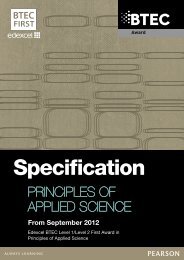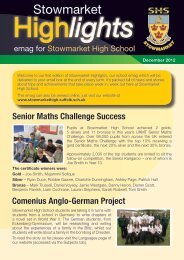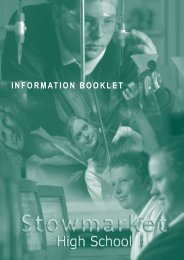BTEC First Award in Application of Science - specification - Edexcel
BTEC First Award in Application of Science - specification - Edexcel
BTEC First Award in Application of Science - specification - Edexcel
You also want an ePaper? Increase the reach of your titles
YUMPU automatically turns print PDFs into web optimized ePapers that Google loves.
UNIT 6: APPLICATIONS OF PHYSICAL SCIENCE<br />
Learn<strong>in</strong>g aim B: Investigate forces<br />
The follow<strong>in</strong>g <strong>in</strong>vestigations are examples that could be carried out to enable learners<br />
to ga<strong>in</strong> evidence to achieve the appropriate assessment criteria:<br />
● <strong>in</strong>vestigate the use <strong>of</strong> frictional forces for different road conditions<br />
● <strong>in</strong>vestigate the safety features <strong>of</strong> modern cars that <strong>in</strong>volve forces<br />
● <strong>in</strong>vestigate the effect <strong>of</strong> unbalanced forces on an accelerat<strong>in</strong>g mass.<br />
To achieve 1B.4, learners must provide evidence to identify at least two examples <strong>of</strong><br />
balanced and two examples <strong>of</strong> unbalanced forces on objects.<br />
For 2B.P4, learners need to extend what they have done <strong>in</strong> 1B.4 by describ<strong>in</strong>g the<br />
effect on objects <strong>of</strong> balanced and unbalanced forces.<br />
For 1B.5, learners need to describe the work done by forces act<strong>in</strong>g on objects for at<br />
least three different forces through different distances.<br />
For 2B.P5, learners need to calculate the work done by objects for at least three<br />
simple experiments, us<strong>in</strong>g the appropriate formulae and units.<br />
To achieve 2B.M3, learners need to use the equation <strong>in</strong> B.5 <strong>of</strong> the content to<br />
calculate the force on objects, <strong>in</strong> relation to their mass and acceleration for a<br />
real-life application.<br />
For 1B.6, learners need to identify friction forces and situations where they occur.<br />
This could be written <strong>in</strong> the form <strong>of</strong> a table.<br />
For 2B.P6, learners can further develop 1B.6 and carry out a friction experiment to<br />
demonstrate friction and normal reaction forces <strong>in</strong> response to an applied force, and<br />
then write a description.<br />
To achieve 2B.M4, learners would then need to apply what they have learnt to<br />
expla<strong>in</strong> how friction and normal reaction forces are produced <strong>in</strong> response to an<br />
applied force.<br />
For 2B.D3, learners need to apply their understand<strong>in</strong>g <strong>of</strong> forces to a variety <strong>of</strong><br />
applications by expla<strong>in</strong><strong>in</strong>g the various forces <strong>in</strong>volved, and their approximate sizes<br />
as shown, for example, <strong>in</strong> content B.8 and B.9.<br />
Learn<strong>in</strong>g aim C: Investigate light and sound waves<br />
The follow<strong>in</strong>g <strong>in</strong>vestigations are examples that could be carried out to enable learners<br />
to ga<strong>in</strong> evidence to achieve the appropriate assessment criteria:<br />
● <strong>in</strong>vestigate the use <strong>of</strong> light waves with regard to mirrors, lenses and prisms<br />
● <strong>in</strong>vestigate the use <strong>of</strong> sound waves with regard to reflection and transmission.<br />
To achieve 1C.7, learners need to draw diagrams to show the reflection <strong>of</strong> light <strong>in</strong><br />
plane mirrors and demonstrate an understand<strong>in</strong>g <strong>of</strong> how plane mirrors are used for<br />
simple applications.<br />
For 2C.P7, learners need to extend 1C.7 by us<strong>in</strong>g plane mirrors and glass<br />
blocks/prisms to show reflection and refraction by draw<strong>in</strong>g ray diagrams and<br />
understand<strong>in</strong>g their use for simple applications.<br />
For 2C.M5, learners need to describe how lenses and mirrors, which are concave and<br />
convex, can affect rays <strong>of</strong> light.<br />
For 2C.D4, learners need to apply their knowledge from 2C.M5 to expla<strong>in</strong> how<br />
reflection and refraction <strong>of</strong> light can be used as <strong>in</strong> content C.10 and C.11.<br />
To achieve 1C.8, learners need to describe how sound is reflected, and how it is used<br />
by bats and <strong>in</strong> simple applications such as echo sound<strong>in</strong>g and on submar<strong>in</strong>es.<br />
BF029957 – Specification – <strong>Edexcel</strong> <strong>BTEC</strong> Level 1/Level 2 <strong>First</strong> <strong>Award</strong> <strong>in</strong> <strong>Application</strong> <strong>of</strong> <strong>Science</strong> –<br />
Issue 1 – March 2012 © Pearson Education Limited 2012<br />
59








